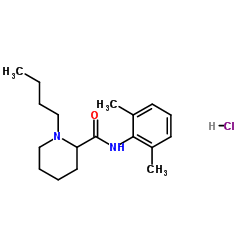Bupivacaine hydrochloride

Bupivacaine hydrochloride structure
|
Common Name | Bupivacaine hydrochloride | ||
|---|---|---|---|---|
| CAS Number | 18010-40-7 | Molecular Weight | 324.889 | |
| Density | N/A | Boiling Point | 423.4ºC at 760 mmHg | |
| Molecular Formula | C18H29ClN2O | Melting Point | 107.5 to 108ºC | |
| MSDS | N/A | Flash Point | 209.9ºC | |
Use of Bupivacaine hydrochlorideBupivacaine Hydrochloride is a local anaesthetic drug belonging to the amino amide group.Target: OthersBupivacaine hydrochloride is an effective local anesthetic agent. It has a rapid onset time, a high frequency of surgical anesthesia, a long duration, and a low incidence of side effects [1]. Median doses of bupivacaine (in milligrams per kilogram) producing asystole in protocol 1 were for 17.7 for saline, 27.6 for 10% Intralipid, 49.7 for 20% Intralipid, and 82.0 for 30% Intralipid (P < 0.001 for differences between all groups). Differences in mean +/- SE concentrations of bupivacaine in plasma (in micrograms per milliliter) were significant (P < 0.05) for the difference between saline (93.3 +/- 7.6) and 30% Intralipid (212 +/- 45). In protocol 2, lipid infusion increased the dose of bupivacaine required to cause death in 50% of animals by 48%, from 12.5 to 18.5 mg/kg. The mean lipid:aqueous ratio of concentrations of bupivacaine in a plasma-Intralipid mixture was 11.9 +/- 1.77 (n = 3) [2]. |
| Name | bupivacaine hydrochloride (anhydrous) |
|---|---|
| Synonym | More Synonyms |
| Description | Bupivacaine Hydrochloride is a local anaesthetic drug belonging to the amino amide group.Target: OthersBupivacaine hydrochloride is an effective local anesthetic agent. It has a rapid onset time, a high frequency of surgical anesthesia, a long duration, and a low incidence of side effects [1]. Median doses of bupivacaine (in milligrams per kilogram) producing asystole in protocol 1 were for 17.7 for saline, 27.6 for 10% Intralipid, 49.7 for 20% Intralipid, and 82.0 for 30% Intralipid (P < 0.001 for differences between all groups). Differences in mean +/- SE concentrations of bupivacaine in plasma (in micrograms per milliliter) were significant (P < 0.05) for the difference between saline (93.3 +/- 7.6) and 30% Intralipid (212 +/- 45). In protocol 2, lipid infusion increased the dose of bupivacaine required to cause death in 50% of animals by 48%, from 12.5 to 18.5 mg/kg. The mean lipid:aqueous ratio of concentrations of bupivacaine in a plasma-Intralipid mixture was 11.9 +/- 1.77 (n = 3) [2]. |
|---|---|
| Related Catalog | |
| References |
| Boiling Point | 423.4ºC at 760 mmHg |
|---|---|
| Melting Point | 107.5 to 108ºC |
| Molecular Formula | C18H29ClN2O |
| Molecular Weight | 324.889 |
| Flash Point | 209.9ºC |
| Exact Mass | 324.196838 |
| PSA | 32.34000 |
| LogP | 4.70940 |
| Storage condition | 2-8°C |
| Hazard Codes | T+: Very toxic; |
|---|---|
| Risk Phrases | R26/27/28 |
| Safety Phrases | 22-36/37/39-45 |
| RIDADR | UN 2811 6.1/PG 2 |
| RTECS | TK6125000 |
| Packaging Group | II |
|
Differential requirement for IL-2 and IL-15 during bifurcated development of thymic regulatory T cells.
J. Immunol. 193(11) , 5525-33, (2014) The developmental pathways of regulatory T cells (T(reg)) generation in the thymus are not fully understood. In this study, we reconstituted thymic development of Zap70-deficient thymocytes with a tet... |
|
|
Inhibition of murine cardiomyocyte respiration by amine local anesthetics.
Eur. J. Drug Metab. Pharmacokinet. 39(4) , 293-9, (2014) The hydrophobic amino acyl amide-linked local anesthetics (e.g., lidocaine and bupivacaine) impose potent cardiac toxicity and direct mitochondrial dysfunction. To investigate these adverse events, an... |
|
|
MK-801-induced behavioural sensitisation alters dopamine release and turnover in rat prefrontal cortex.
Psychopharmacol. Ser. 232(3) , 509-17, (2015) Repeated exposure to psychostimulants that either increase dopamine (DA) release or target N-methyl-D-aspartate (NMDA) receptors can induce behavioural sensitisation, a phenomenon that may be importan... |
| Marcaina |
| Bupivacaine hydrochloride |
| Sensorcaine |
| Marcaine |
| Bupivacaine (hydrochloride) |
| 2',6'-Pipecoloxylidide,1-butyl-,monohydrochloride |
| bupivacaine HCl |
| 1-Butyl-N-(2,6-dimethylphenyl)piperidin-2-carboxamidhydrochlorid |
| 1-Butyl-N-(2,6-dimethylphenyl)-2-piperidinecarboxamide monohydrochloride |
| Einecs 241-917-8 |
| Win 11318 HCl |
| Bupivacaine hydrochloride(Marcain) |
| BUPIVACAINE HYDROCHLORIDE ANHYDROUS |
| UNII:AKA908P8J1 |
| 1-butyl-N-(2,6-diméthylphényl)pipéridine-2-carboxamide chlorhydrate |
| bupivacaine monohydrochloride |
| 1-butyl-piperidine-2-carboxylic acid-(2,6-dimethyl-anilide),hydrochloride |
| 2',6'-Pipecoloxylidide,1-butyl-,hydrochloride (6CI) |
| Marcain |
| 1-butyl-N-(2,6-dimethylphenyl)piperidine-2-carboxamide hydrochloride |
| 1-Butyl-N-(2,6-dimethylphenyl)-2-piperidinecarboxamide hydrochloride (1:1) |
| 1-Butyl-N-(2,6-dimethylphenyl)piperidine-2-carboxamide hydrochloride (1:1) |
| 2-Piperidinecarboxamide, 1-butyl-N-(2,6-dimethylphenyl)-, hydrochloride (1:1) |
| Bicain |